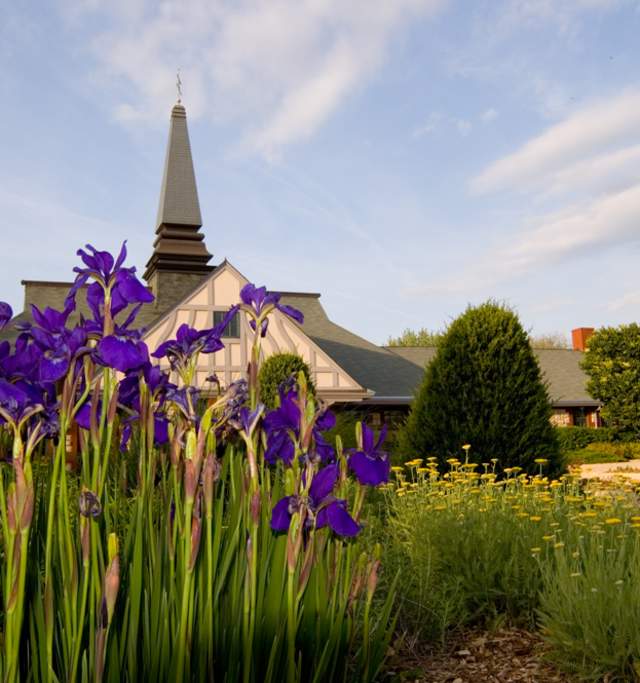Historic Sites of Douglas County
Local Preservation Success Stories
By Jan Shupert-Arick, Douglas County Heritage Coordinator
Douglas County, Kansas, invites you to celebrate local preservation success stories by visiting local sites listed on the National Register of Historic Places and the Register of Historic Kansas Places:
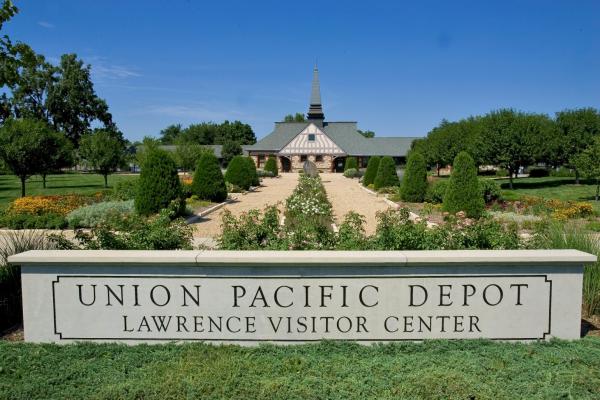
Union Pacific Depot
402 N. 2nd Street, Lawrence, KS
The trains still run the tracks on the south side of the old Lawrence Union Pacific Depot built in 1888-1889 by the Union Pacific Railroad. Constructed of Johnson City limestone, pressed brick and Colorado red stone, the station had a central ticket office at track side and separate waiting rooms for men and women. Slate shingles covered the roof of the 153’ by 30’ structure. The building was designed by Henry Van Brunt, one of the top five architects in the nation during the late 19th Century. The Union Pacific discontinued passenger service in 1971, but used the building for freight until 1984. Efforts by the Save the Depot Task Force persevered in its fight to preserve the structure which was deeded to the city of Lawrence in 1991. The awning and the spire were both reconstructed.
Baker University – Old Castle Museum
513 5th Street, Baldwin City, KS
The Old Castle Museum is open to the public every Saturday and Sunday from 1-4 p.m.
If the walls could only talk, this three story limestone building built in 1858 would begin its story by bragging that it was Kansas’ first four-year university building. Known originally as “The College Building,” the Old Castle currently houses artifacts and memorabilia from the Methodist circuit-rider, Santa Fe Trail history, settlement days, and Baker’s history. This site also includes the Old Palmyra Post Office that once served travelers along the Santa Fe Trail.
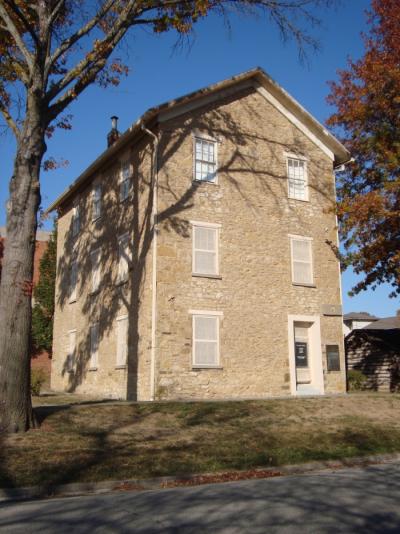
Photo courtesy Baker University

Photo courtesy Douglas County Heritage Office
Coal Creek Library
698 E 1719 Road, Vinland, KS
The library is open from 1:00 pm to 4:00 pm on Sundays, April through October.
Twelve miles southeast of Lawrence, the Coal Creek Library, believed to be the oldest continuously operating library in Kansas has served the Vinland community for over a century. The Coal Creek Library Association was founded in 1859 when neighbors sent $10 to Philadelphia to purchase books. For the next 41 years the volumes were housed in local homes but in 1900 a library building was constructed on a lot purchased for $10. Take a step back in time in Vinland.
Oregon Trail-California Trail Segment and Nature Trail
867 U.S. 40 Highway, Lawrence, Kansas
The First United Methodist Church along U.S. 40 west of Lawrence proudly protects a segment of the Oregon and California Trail that at one time served as a major transportation corridor to the West. It is said that over 400,000 pioneers traveled the route from 1840 to 1860. The Oregon Trail was the main route used by American emigrants looking for land and business ventures. The route stretched 2,000 miles over the Great Plains and the Continental Divide, ending in the fertile lands of the Willamette Valley of Oregon or the gold fields of California. The migration left its mark on the American frontier. Decades of wagon wheels carved ruts along the trail, left imprints in stone, and wore down the open prairies. While at the site, take a hike along the nature trail south of the church and enjoy views of Lawrence, local farms, and native prairies.
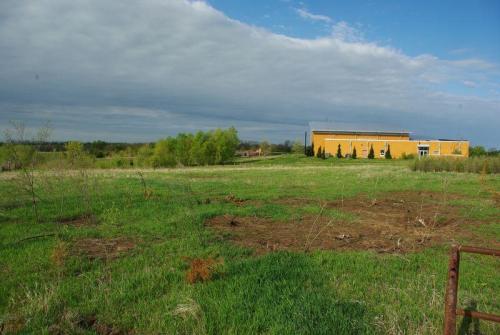
Photo courtesy Kansas State Historical Society
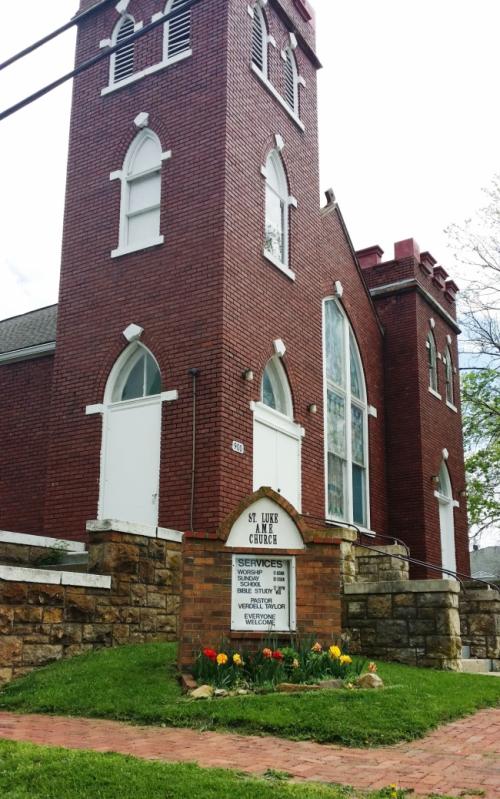
Photo courtesy Douglas County Heritage Office
St. Luke A.M.E. Church (Constructed in 1910)
900 New York Street, Lawrence, Kansas
Organized in 1862, the early years of the church did not include this location or building. Services were held in a blacksmith shop in the 700 block of Massachusetts Street. At the time of Quantrill’s Raid on Lawrence (August 21, 1863), St. Luke had begun construction of a new church at the corner of New Hampshire and Warren (9th) Streets. On that fateful day, a company of 25 military recruits was encamped on the site. Twenty men were killed by the raiders and thrown in the foundation trenches. The site was then abandoned and a stone building bordering the alley was erected on the rear of the present lot at 900 New York Street. Escaped and freed enslaved people and their children became members of St. Luke. Many members of the congregation came to Lawrence through the Underground Railroad which operated on the west bank of the Missouri River, and stretched across eastern Kansas and into Douglas County.
Constitution Hall – Kansas State Historic Site
319 Elmore Street, Lecompton, Kansas
Hours: Wednesday – Saturday 9-5, Sunday 1-5.
Admission: $3 Adults & $1 Students
Schedule a guided tour of Constitution Hall – call (785) 887-6520
Constitution Hall was designed in the Greek Revival style and built by Samuel J. Jones in 1856-1857. This building is said to have been one of the busiest and most important places in the Kansas Territory. Thousands came to file claims in the U.S. Land Office on the first floor and the District Court held sessions on the second floor. The Lecompton Constitutional Convention met here to draft a constitution to gain statehood for Kansas. Newspaper reporters from across the nation gathered in Lecompton to report on the meetings. Because the Lecompton Constitution protected slavery, many feared a national civil war would break out if the convention could not satisfy both proslavery and antislavery forces. Eventually the Lecompton Constitution failed and Kansas was admitted as a free state in 1861. Since those early days, Constitution Hall has served as a dry goods store, hotel, dormitory, undertaker’s office, and a lodge. Today the building is a Kansas State Historic Site.
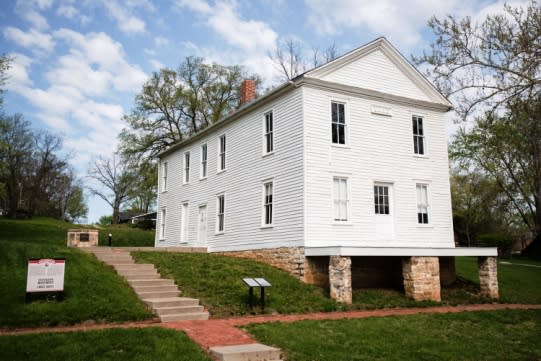
Photo courtesy Jerry Wang/Lecompton Historical Society
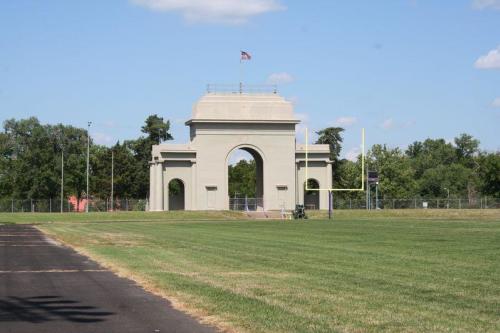
Photo courtesy Kansas State Historical Society
Haskell Arch and Stadium
Haskell Indian Nations University
2300 Barker Avenue, Lawrence, Kansas
At Haskell Indian Nations University stands a massive memorial ARCH. It was constructed in 1926 to honor 415 soldiers from Haskell who served in World War I. Two Quapaw Haskell alumnae, Agnes Quapaw-Hoffman and Alice Beaver Hallam, paid for its construction. Markers are on the Memorial Arch are located at the south end of the football stadium about 300 feet southeast of the intersection of Barker and Pawnee Avenues. The adjacent football stadium is said to be the first lighted stadium in the Midwest. To learn more about the history of HINU, visit the Cultural Center and Museum at 155 E. Indian Avenue. The Cultural Center is open 9 am to 4 pm Monday-Friday.


